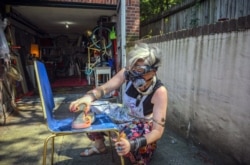Many creative people move to New York City in hopes of one day getting a job in show business or the arts. They often work as waiters in bars or restaurants while hoping for a big break as a performer, painter or writer.
But the coronavirus health crisis has put many servers out of work in recent months as eateries were forced to suspend their in-house dining services. And the future of what restaurant dining will look like is unclear even as New York City reopens.
Some people wonder whether there will be enough business for bars and eateries to stay open and even have server jobs to fill. This raises questions about what that will mean for New York’s creative class. Many servers fear the jobs that helped them live in the city and add to its artistic culture are no longer readily available.
Travis McClung grew up in Texas. He told the Associated Press: “It really is a part of the artist’s life in New York, so I don’t know what that’s going to look like if it’s just suddenly not an option anymore.”
McClung moved to New York in 2009 to study theater in college. Now 28-years-old, he has spent close to nine years serving food while doing theater, singing and more recently, trying to build his career in video production.
The virus has been especially damaging for the city’s restaurant workers. The New York State Department of Labor reports that restaurants and other eateries employed just over 273,000 people in February 2020. But that was before the city started closing down in March to fight the spread of COVID-19. In April, as case numbers jumped, the number of employees had fallen to under 78,000.
As the city began reopening in May, the number rose to close to 100,000, still far below where it had been.
New York has permitted outdoor dining service in recent weeks. Around 6,600 of the city’s restaurants have requested permits to feed people on sidewalks and streets. But the return of indoor service has been delayed over fears that enclosed spaces would make virus cases rise.
Rachel Berry moved to New York City from Maryland in 2004. She tried several different jobs like dog walking and childcare before moving to food service in 2016.
Berry even spent some time at a traditional office job. But she found the structure too rigid to give her enough time to work on her creative interests. These have included painting, performing and most recently, interior design work.
She worries now about what will be available in restaurants, as social distancing restrictions require eateries to limit crowds in the weeks to come. She also worries whether she would have to work even more in other jobs to make what she has been able to in food service.
“Am I going to have the same opportunities afforded to me financially, or, you know, am I going to be stuck in this, I need two to three jobs to get by,” Berry asked.
Jen Lyon is the owner of MeanRed Productions, a company that organizes arts and music events. She worries that creative people may leave New York, or choose not to come there at all, because of the high cost of living.
As someone who spent years bartending, she understands the importance for food service jobs and what they offer creative people.
They are the best jobs to have when you need to focus on your art, especially in New York, she said.
But now, if many of those jobs disappear, “What happens in my world is suddenly I don’t have young artists to work with because they can’t afford New York,” she said. “You don’t have people creating art in New York anymore.”
Losing creative people is also a “huge threat” to the city, said Eli Dvorkin. He serves as editorial and policy director at the Center for an Urban Future, which supports policies that make New York more equitable.
“As a city we can’t afford to lose our creative edge. It’s been one of the … drivers of the city’s economic growth over the past decades,” Dvorkin noted.
I’m Pete Musto.
Deepti Hajela reported on this story for the Associated Press. Pete Musto adapted it for VOA Learning English. George Grow was the editor.
We want to hear from you. Write to us in the Comments Section.
________________________________________________________________
Words in This Story
bar(s) – n. a building or room where alcoholic drinks and sometimes food are served
break – n. a lucky situation or event that makes success possible
option – n. something that can be chosen
rigid – adj. not easily changed
opportunities – n. amounts of time or situations in which something can be done
afford(ed) – v. to supply or provide something needed or wanted to someone
bartending – v. serving drinks at a bar or restaurant
focus – v. to direct your attention or effort at something specific
equitable – adj. just or fair
decade(s) – n. a period of 10 years









